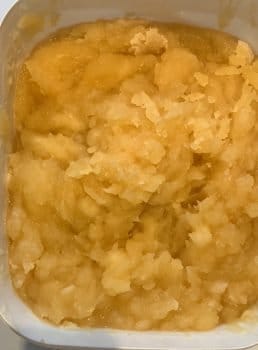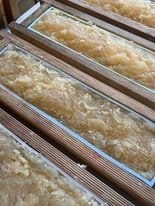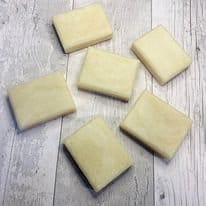Blogtober 2021 – Day 6
During the summer, while I was trying to button down the fragrances I wanted to use for the autumn specials, I came across the most amazing Toffee Apple fragrance. Unfortunately it was an absolute nightmare to use in cold process soap. It massively accelerated trace, and did actually turn the soap solid in the bucket before I could even think about adding colour, never mind pour it into moulds. Nevertheless, I adored the fragrance and decided to break with tradition and offer my customers a soap made using the hot process method. If you’re not sure what that is – check out this post
Now I’m really not an expert at this method, and while some people can make amazing looking soap this way, my attempts have always been pretty basic and rustic looking, with no fancy swirls or patterns, and that was just how this one came out.

I honestly didn’t think I would sell very many at all, so only made 30 bars, but completely underestimated my lovely customers loyalty and preparedness to try something new and sold out within the hour – arrghh! I felt duty bound to make more PDQ, which I did. A couple of days ago.
Hot process soap is generally made in a slow cooker / crockpot, and is so called because additional heat is added to the soapmaking process to speed up saponification. However, knowing how quickly this fragrance accelerates trace, I dispensed completely with the crockpot but made sure that my oils and lye solution were significantly hotter than I would normally have them. I added the fragrance to the heated oils and butters first and mixed very well, to ensure that it was completed incorporated. I then slowly added the hot lye solution to the oils and mixed well again. It turned solid in the bucket quite quickly, and I let it sit for a while it continued to heat up. This is NOT something I would recomend for any beginner soapmakers, overheated caustic soap batter is dangerous.
I’ve tried to upload a video of the mixing of the batter but I can’t seem to get it work, but here are a couple of photos:


Once I was happy that it was all thoroughly mixed and of the right ‘vaseline-like’ texture I plopped it into the moulds. They’re certainly not the most beautiful ‘in-the-mould’ photos 😉

Yesterday I unmoulded and cut the loaves and I’m really happy with how they turned out. While I usually give my regular bars a full 6 weeks cure time, these psuedo-hot process bars don’t need quite so long, and will be available for purchase on, aptly enough, 31st October.

Thanks for reading – back tomorrow for Day 7

